Has COVID-19 Changed Your Daily Life?
- Jun 9, 2020
- 0 Comments

By Gabe Ryan, School Health Blog Writer & Contributor
Has COVID-19 changed your daily life? The degree of change is different for everyone! When the news first started building that more and more cases of COVID-19 were being confirmed across the country, I wondered at what point I’d hear of towns or counties being affected near me. About a week later, I was sitting in a parking lot waiting to go into an appointment and a news alert came across my phone. The County Superintendent of Schools was holding a press conference about a local high school basketball team, ranked 6th in the state, that would not be playing in an upcoming tournament game due to concerns over COVID-19. This was very upsetting for the players and parents, as many college scouts were expected to be in attendance. At the time, there were no closures and no confirmed cases for the virus at that school. The state guidance had just been released and schools were grappling with how to keep students safe. Similar stories swept the nation, as all communities tried to sort through the massive amount of information, guidance, and opinions.
It was not too long after that press conference that there was an increase in identified cases of the virus in the state and a statewide stay-at-home order was issued for California. We have now spent almost three months under a stay-at-home order. The numbers of people locally who have been sick or have died from this virus have not been as staggering as other cities and regions. I fall into a high-risk category with a pre-existing condition, and because of this I have limited my exposure to others throughout these last few months.
At first, I was glued to television, social media, and radio trying to understand the impact and how all this information would relate to me. As the weeks progressed, I tried different ways to approach everyday activities related to well-being, safety, and preparedness. Here are a few examples from my personal experience during the last few months:
- I have always attended medical appointments in person. With appointments being canceled at clinics, I was offered a Teledoc appointment with my Sports Medicine physician. This was a first for me, it was easy to use and something I could do independently on an iPad.
- Instead of attending weekly in-person Physical Therapy appointments, my therapist emailed a home program with video and picture examples that I could independently follow for flexibility and strength training.
- Rearranging my workspace location helped to minimize distractions, improve focus, and have a little more natural light. I even added a plant!
- Stayed in touch with friends and family through video calls and texting, since we were not able to meet up in person.
- I have learned how to order groceries online for pick-up at my local store. This was a much better option for me than early store hours, waiting in line, constantly changing rules for entrance, and racing others to the toilet paper aisle.
- Making sure to get outside a little each day, either rolling along on the bike trail or just sitting outside in the sun for a while. Staying hydrated with the Giraffe water bottle and listening to music.
- Generally, I already prefer to keep a routine, but with family working from home and everyone’s schedule shifting, I learned to be a bit more flexible all around.
- Luckily, the care providers I rely on for support are considered “essential workers” in our state, this certainly made changes to everyday activities a little smoother.
- Through doing research online, I have found and tried new lunch and dinner recipes with my family. I also learned I am able to operate the touch button coffee grinder.
- Many agencies that offered presentations in-person, switched to offer virtual mode, and waived the cost. I enrolled in online webinars and short trainings. There have been amazing resources made available online from virtual tours of museums and landmarks, group discussions, all kinds of learning resources for teachers, parents, and students.
- Having a few extra supplies on hand is helpful in case of emergency. It is often suggested to keep a small amount of cash on hand for emergencies, however several businesses around me, were not accepting cash these last few months. Having an alternate payment method is a good addition to your preparedness list.
I have missed meeting up with my friends and family in-person, going out to eat, in-store shopping, participating in events and traveling to conferences and meetings, and being out in the community in general. In fact, I had tickets to attend my first hockey game with accessible seats, my whole family planned to attend, then the National Hockey League cancelled all games. This uncertain time has certainly had its challenges, but I have learned some new skills and approaches that I will be able to use long after the stay-at-home orders are lifted.
The degree of change is different for everyone, from challenges they have faced to new solutions discovered. We have all had an opportunity to look at things from a whole different perspective.
